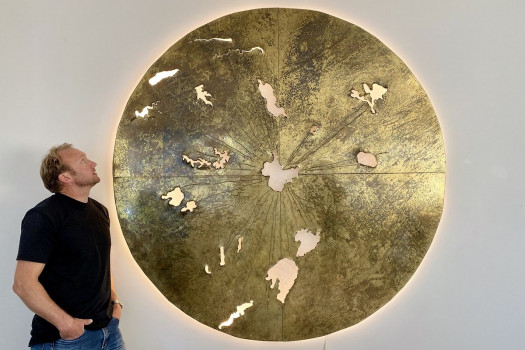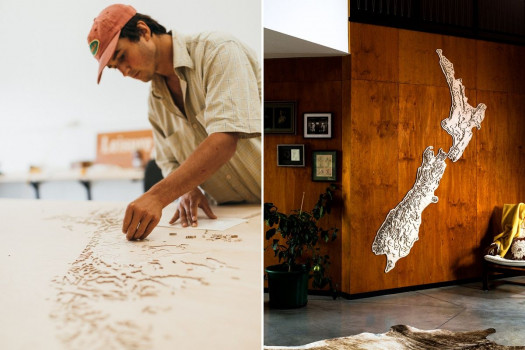Instagrammable moments



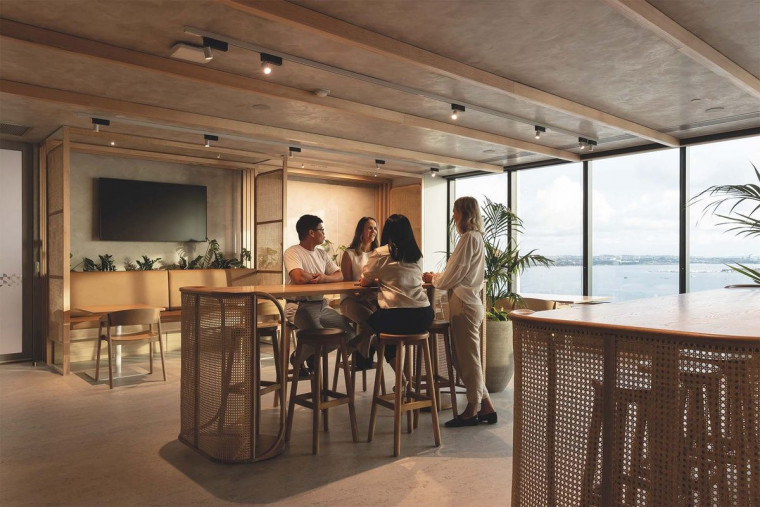
Scott Compton discusses changing workplace design in the age of Covid, the rise of the distributed campus model and creating magnetic, experiential workspaces for empowered employees.
The title of Veldhoen + Company’s project journal for Macquarie Group’s One Shelley Street in Sydney is It’s Not About the Building. The publication details the financial giant’s revelatory move to team a Californian interior designer with a Dutch workplace strategist to win the battle for talent through progressive workplace practice. Ostensibly, it turned the bank from a corporate filing cabinet into a MacBook overnight.
The journal summarises the cultural impact of workplace design, along with a healthy dose of marketing the virtues of Activity Based Working (ABW). At the time, this was the go-to model for offices but have things changed 10 years on? While ABW is now commonplace in large organisations, there is a more nuanced discussion around agility and which ‘agile’ spaces are conducive to productive work. Most companies adopt sharing ratios of their work points, based on long-observed data that points out that spaces are often at 70 per cent capacity and rarely full on a day-to-day basis. There are furniture and spatial solutions for everything and, while many of these are gimmicks, some, such as the small video conferencing rooms now prevalent in most workspaces, have enhanced the ways in which we interact.
While technological progression and a pandemic have seen the world of workplace design continue to evolve at pace, the message remains the same – it’s not about the building. If a workplace cannot be measured and judged by its physical design, which is purely additive to a bigger picture, by what is it measured and why? To answer this, we need to go back to the root of the challenge of a workplace, which is to identify the needs of its working population. We need to quantify and study workplace behaviours and amplify the influence of the inherent culture of the brand that entices people to join it.

Shared workspaces in the lobby at HSBC Tower, with seating and WiFi, are open to the public. Image: Jono Parker
Work from anywhere
If we look at the acceleration of technology in the past 20 years, the transformation of digital tools into enablers of mobility has empowered the individual to be more selective about how and where they work. Tech agility has untethered the user from real estate and the need to be in a particular place to work. WiFi, Bluetooth, VPNs (virtual private networks) and other high-powered wireless capabilities have dealt the workplace a significant blow – technology is no longer the fundamental reason for a person to be in a purpose-built space to undertake their work. Big Tech businesses have known for some time that having good tech hygiene is an enabler but not a place-maker. If businesses like Google and Vodafone have known this since the early 2000s, why has it taken a pandemic to uncouple the relationship between working in an office and working from home? The answer is trust. The pervading lack of trust is brought about by some business leaders’ continued belief in the presenteeism theory; if employees cannot be seen to be doing work, they are not trusted to undertake their work. Amazingly, this is still evident in many workplaces.
The pandemic has shifted organisational mindsets to offer work from home as a necessary facility of the employee experience. A simplistic view has developed, where one is either ‘at the office’ or ‘at home’ and that business protocol and processes should cater for both those environments. But, it is not as simple as the home becoming an extension of one’s office; what the pandemic has opened up is the ability to work from anywhere. With trust and technology in place that enable employees to roam, they can choose their destinations and preferred modes of work, and move as they see fit. This is where things become tricky for business owners and workplace designers. In order to lure people back into the workplace, we are competing not only against their homes but also against every single fit-for-purpose, WiFi-enabled facility in the city. Cafés, lobbies, co-working suites, wellness spaces and parks are all perfectly adequate workspaces, should the employee have the appropriate task to undertake in them.
The most interesting developing workplace mode is the distributed campus model, which organisations such as WPP (considered the world’s largest advertising company) and Big Tech are adopting. Multiple sites throughout a city offer different buildings in which to work – a type of co-work, with unique identities at each site but consistent tools and tech. While multi-site organisations are nothing new, the potency in this version is that the power of choice lies with the employee, not the employer. This model enables better workplace investment; it consolidates spend and avoids duplication on larger sites, by offering more diverse and extensive suites of spaces that support productive work. This manifests in different types of wellness spaces, food offerings, meeting and event spaces, and unique creative environments, such as workshops, play spaces and things that are traditionally considered purely recreational. Employees can situate themselves where they feel most comfortable to work on a given task. Described by a Google employee as ‘workplace tourism’, having a choice of destinations from which to work offers a potent blend of stimuli and cross-communication, and leads to a richer network of relations across the business. Variety is the spice of life.
For this model to be successful, a workplace or campus must provide safety and support for its people, not only through leadership and mentoring but also by way of security and stability. It is no coincidence that Big Tech sees security as a top agenda for its workplaces and people. Culture thrives when we are allowed to embrace failure and, for this to happen, the workplace must truly be a ‘safe place’. Privacy and support for employees is non-negotiable and this is evident in the growth of multi-faith and parenting rooms, and wellness, mental and physical well-being spaces dotted around workplaces that understand the cultures of their people. If the workplace is the safest place for employees to be, it will also be much higher on the trust index.
The paradox here is that the trend of monitoring employees’ locations and behaviours while on campus will become more prevalent. A worker’s phone is their beacon; it is the link to data and evidence that businesses will monitor to improve productivity. It is commonplace for workplace design to follow the path of evidence through data – traditionally, data was gathered visually by people and the employees were aware of it. With technological advancement, the data is automatically captured digitally, through smart systems linked to work points, lockers and meeting rooms. The future will leverage employees’ phones, with permission, and, no matter how scary that might be, it already happens – we are being watched and this is contrary to the privacy required to achieve trust.
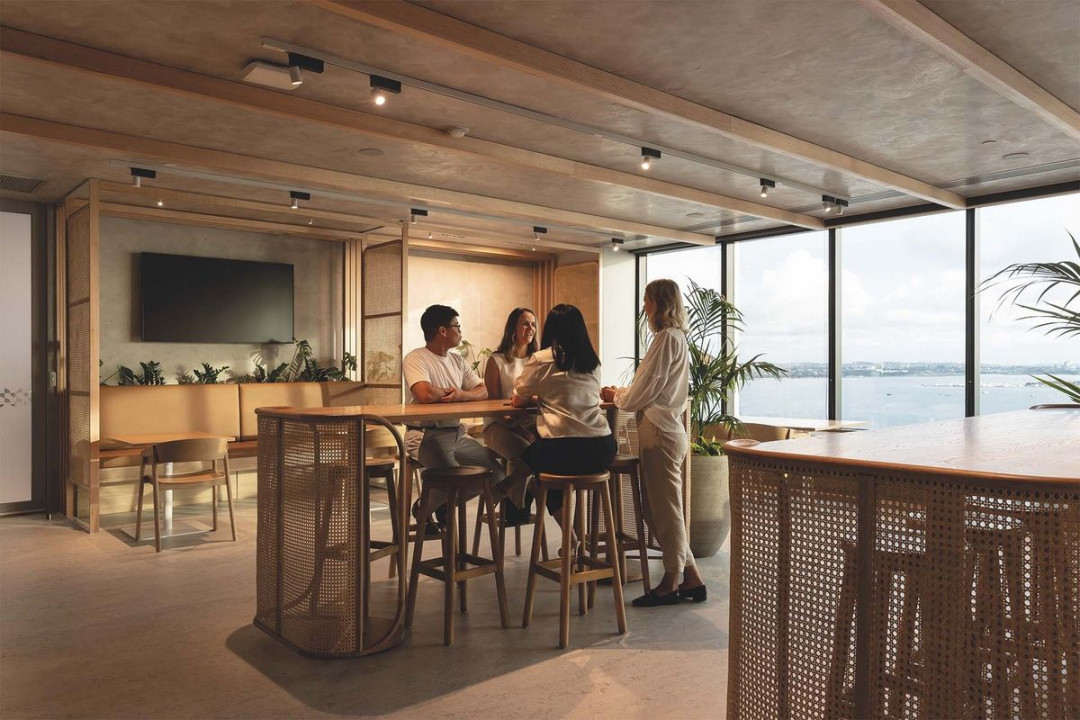
Buddle Findlay’s social space is a softened, hospitality-style experience where employees can come together. It is equal to any client experience. Image: Jono Parker
Culture that differentiates
A workplace is the only place that can culturally unite a group of minds with a common purpose. No home, café or lobby can ever offer that. As one of our industry-leading technology partners says: “We need a place to come together and to rally around things that matter.” People come together to deal with big issues and the power of many can make a difference, providing the ability for each to speak their mind and find the like-minded to share in the experience.
In the current and likely future era of work, employees are very much attuned to the bigger climate and societal issues that organisations are tasked with solving so the culture of a business is often considered more important than are financial or other incentives. How a business responds to these issues is significant. Workplaces must embody the meaningful cultural positions they represent – the words diversity, inclusion and sustainability are commonplace in corporate culture now. Without them, it is simply not possible to attract the ‘next gen’. This manifests in distinctive workplace outcomes if harnessed correctly and aligned employees will recognise this and celebrate it in their own forum.
A workplace must reflect the unique characteristics of its brand, projecting the company’s ideals and providing moments where employees can take selfies and convey those values to their peers. Digital projection, acceptance or even rejection of the reinforcement of personal values and ethics is an important and necessary process of modern culture. All workplaces should consider ‘instagrammable’ moments because they offer employees the ability to project pride in their decision to work there.
Working at Google is of enormous pride to its employees because, in their minds, there is a genuine ability to make change, at scale, across the globe. Google’s workplaces cater for nearly every imaginable desire and each destination is locally embellished to speak to its native location. The broad theory applied by these organisations is that the more they provide for and support the employee lifestyle, the less distraction there is when it comes to the task at hand. Interestingly, this theory is common with elite sportspeople, each of whom has their every whim catered for to enable their sole focus to be on their training and profession. They literally think about sport 24/7, without distraction, and such streamlining of the mind has proved effective. Perhaps we will reach a new era of ‘elite’ employment programmes.
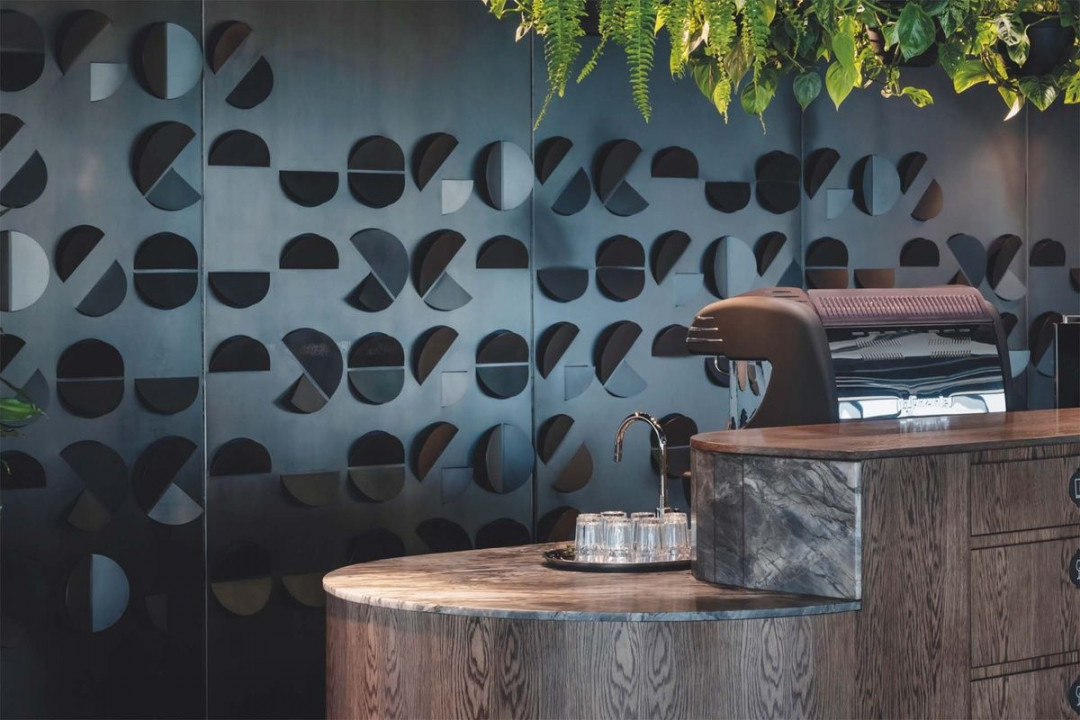
The professional espresso machine at Colliers takes pride of place in the co-work area and is a vital social magnet for bringing employees together. Image: Sam Hartnett
Creating community
Large events and gatherings are under increasing pressure. The pandemic, potentially, will see many seminar spaces mothballed and businesses must now consider their capital investment in workplace event facilities. Do they need to be on site? There is every chance that they could become high-cost, low-yield spaces for health reasons. In recent years, co-working has boomed and, despite initial projections of the potential collapse of the market, we see a different proposition. Take Warren and Mahoney’s Auckland studio – within a 1km radius, there are state-of-the-art hosting facilities we can use for all occasions and at all scales. Generator in Wynyard Quarter, along with its meeting suites in Commercial Bay and 188 Quay Street, offers all the amenities and event experiences without the capital costs. Similar facilities can be found mid-city with other independently operated event spaces. In a campus model, these facilities don’t have to be duplicated – they live in one site, giving that site a purpose and freeing valuable real estate for other important amenities.
Food and wellness facilities are a big cultural catalyst. Big Tech organisations are providers of these in every sense; food is not the reason to come to work, it’s a necessity. Similarly, sports, hobbies, wellness and mindfulness are catered for. Work is life. The more a workplace can cater to its audience and respond to its unified culture, the more likely it is to be a thriving workspace.
Delivering ‘life’ to their people is a significant consideration for all organisations now. Traditionally, the legal, advertising and banking industries all had hierarchical attitudes to amenity. It was reserved for the important people and was earned through merit. That has changed in recent years. In our work with top-tier legal firms, investment in staff amenities and facility is parallel with investment in the client experience. What an organisation offers to its people is a serious bartering tool in the battle for talent. Good coffee won’t necessarily attract employees but bad coffee might well turn them away.
So, the question is, what level of amenity will have the most impact in the workplace and what are the chances that it will remain relevant in the future? It’s a tough one because great hosting brings a social dimension that is pivotal to an organisation’s culture, often as the lynchpin in creating a bond between user and place.
The fundamental issue is that of necessity to create community. The challenge is to broaden that community beyond the walls of your workplace and to create a network of support for everyone that interacts with your business. All roads lead back to the discussion around culture, which is the unique bond and energy of a united community. It appears that to unlock the true potential of a workplace, culture is key.
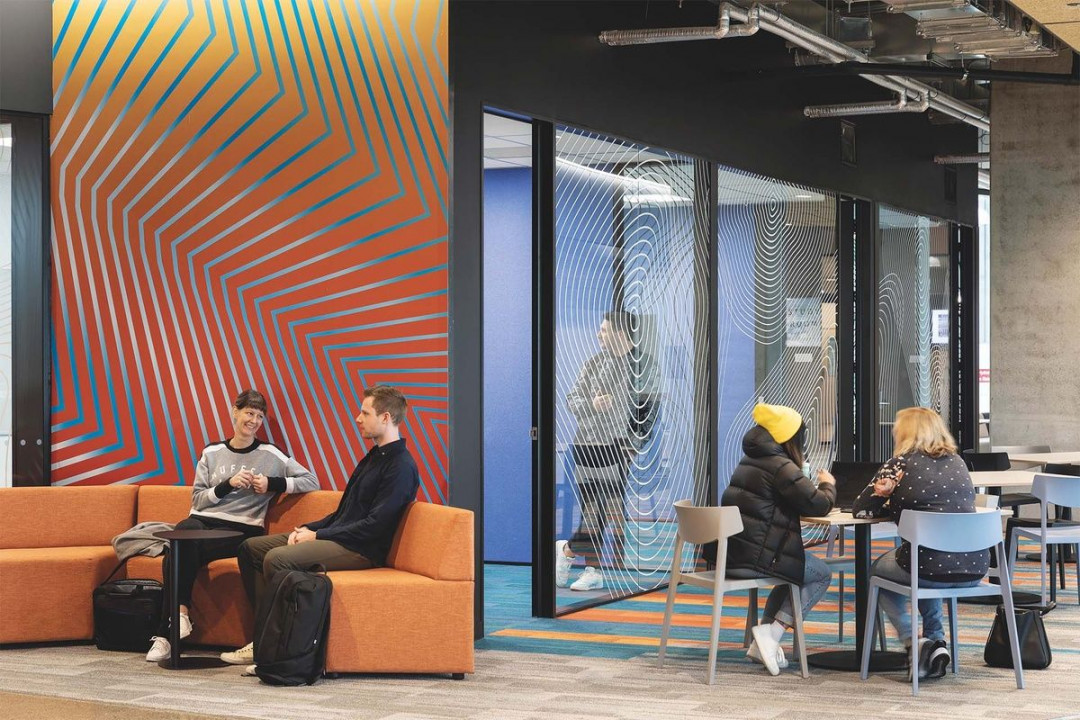
Waipārūrū Hall at the University of Auckland: what can we learn from our tertiary education experience to inform the future of work? Image: Sam Hartnett
Master and apprentice
For legal and professional services, and in our own studio, the workplace is crucial to the growth of employees, particularly those who are graduates or a few years out of education. Every day is a learning day. The danger of working from home is that business leaders are likely to have homes with well-equipped private spaces and access to quality connectivity, enabling high productivity. They have the means to work well from home but young professionals may not have such luxuries. They can be isolated and ill-equipped as a result of their economic and living situations. In isolation, there is no leader adjacent or within earshot; there is no learning by osmosis and less opportunity for ad-hoc conversations. Connectivity to peers and leaders becomes more dependent on booked meetings, dictated by the leader’s meeting schedule, which is likely to be overbooked.
The younger cohort needs the workplace to support their growth, from both general welfare and learning positions. For the ‘workplace’ to work, they need to know that their leader is there and available to support and nurture their growth. This sounds a lot like a tertiary education environment, where the student is autonomous and self-motivated but is reassured by the fact that their tutor is on site, within the network of teaching spaces to which they are assigned, and will be available to mentor when needed. Perhaps the workplace will finally catch up – leaders will dependably reside in the workplace, making themselves available for mentoring and growth. And, in turn, if leaders are to be at home, the employee knows there is a need for privacy and respects the diversity of roles required. The scenario, therefore, is that the workplace is a learning space, purposely catering for interaction and knowledge sharing, with less focus on work points and more on group spaces or interactive areas for sharing that knowledge.

The days of appraising productivity through industrial-era measures are gone. Workplaces need to be magnetic and experiential but, mostly, accepting of all ways of work. Image: Sam Hartnett
Power to the worker
What is the future of work? For the employee, with empowerment and choice available to them, we are at a new frontier. It is one that places the onus on the individual to understand what is important to them, how they wish to go about their business (both technologically and physically) and how to work effectively. Employees should be encouraged to find their ‘flow’. Finding that flow is about embracing longer gestation periods of thought and short sprints of targeted productivity. Endless coffee consumption may, in fact, signal someone toiling deeply over the challenges they have in their mind before action. Harking back to the sporting analogy and the mindset of a sprinter, the race is won on the line if the athlete can find deep focus and visualise the outcome they seek – when they get that right, then the sprint itself is a process of manifesting the vision.
To enhance productivity, we need to shift the power of influence in the way we approach work. When we are briefing with organisations about how we work, the evidence must come from the people, not the leaders. If we follow the evidence, it is more likely that the workplace will reflect the usage and purpose of the spaces being utilised by the employees. Leaders need to be enablers, embracing a vision that creates opportunity and empowerment for employees and measures outputs and not time. This shift requires egos to be left at the door and, with that, everything is up for grabs.
As for the workplace, it’s about creating the right place, at the right time, for the right reason, and remaining relevant while striving to find that unique culture that sets it apart. A workplace cannot be judged by its aesthetic – for a more truthful measure, look for the smiles on people’s faces because creating a unique culture now is more challenging than it ever was.
Scott Compton is Head of Design at Warren and Mahoney’s Auckland studio, advocating an inclusive approach to design to achieve unique outcomes. He has extensive project experience in workplace, retail, hotels and hospitality, having worked in the United Kingdom, China and New Zealand. He is focused on producing innovative environments for renowned brands such as TVNZ, Microsoft, SkyCity, Dexus, Precinct Properties and, more recently, Google.




 Indonesia
Indonesia
 Australia
Australia
 Philippines
Philippines
 Hongkong
Hongkong
 Singapore
Singapore
 Malaysia
Malaysia



